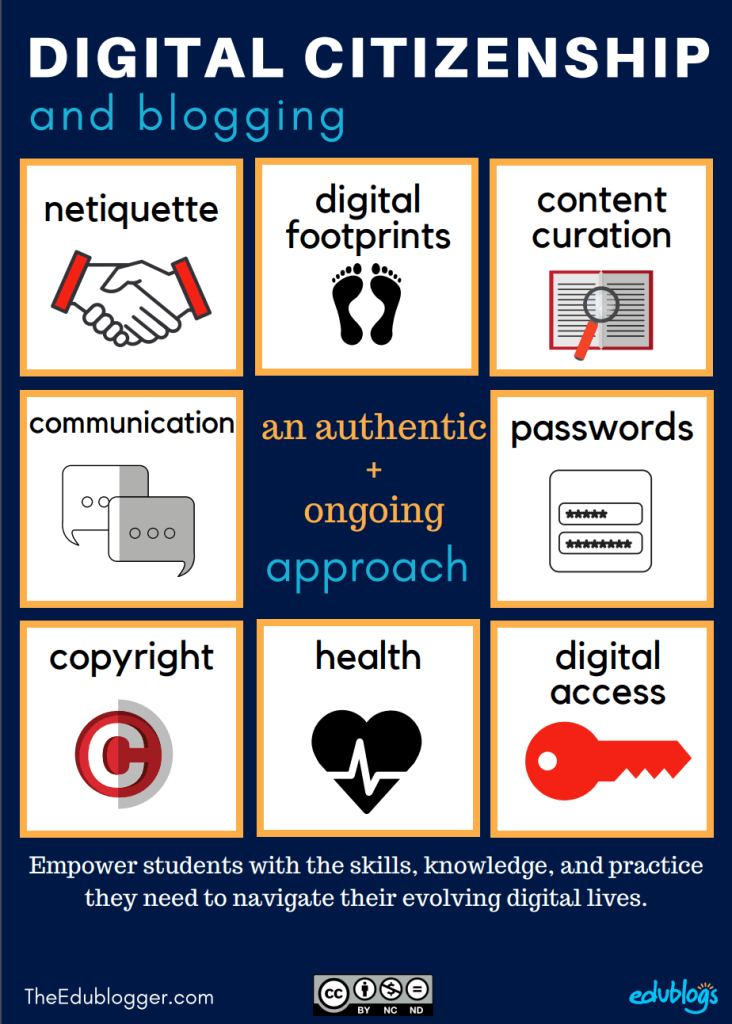Blogging Guidelines
We will be discussing and practicing Digital Citizenship through the blogging topics below.

The information below was modified from the full article here.
1) Netiquette
Commenting on other blogs is a fabulous way to practice and discuss netiquette (online etiquette).
When deciding what makes a quality comment, classes can discuss things such as:
- giving compliments
- delivering feedback constructively
- using positive language
- asking questions and engaging in conversation
- being a reliable online friend
- staying relevant and on-topic
2) Digital Footprints
The whole concept of digital footprints or online reputations is becoming more important than ever.
Publishing on a public blog means putting yourself out there for others to see. While this might seem scary at first, blogging can offer the ideal opportunity to learn and practice the skill of managing your digital identity.
Blogging in the classroom provides that students are guided in the process of publishing online.
3) Content Curation And Creativity
A big part of being an internet user is being able to effectively research, curate, and share information. This involves critical thinking and creativity. Students could develop their skills over time through a blogging program.
John Spencer explains
..if you watch people engaged in creative work, they are often critical consumers of the same type of work they create. There’s this ongoing cycle of critical consuming, inspiration, and creative work. As they create more, it leads to a deeper ability to consume critically, where they find more inspiration, and the cycle continues.
Image: John Spencer, www.spencerauthor.com
Creativity is a skill that’s always going to be in high demand. How amazing would it be if all our students graduated being able to confidently and fluently follow this cycle of critical consuming-inspiration-creative work?
4) Methods Of Communication
Blogging is a popular method of communication. But when you break it down further, you can see that there are many elements to using a blog for communication. These could be:
- written posts
- audio posts
- written comments
- video
- multimedia and embedded content
5) Copyright and Creative Commons
Bloggers quickly learn that they need images to enhance their blog posts. But where do they find images?
Blogging is the perfect way to teach students that the can’t just rely on Google Images and they need to either create their own pictures or use Creative Commons work.
Through blogging, students can learn how to become fluent at sourcing, using, and attributing images.
6) Health And Wellness
Encouraging children to be healthy both physically and mentally has always been a key concern for educators and caregivers. With mounting (real or perceived) pressure to be constantly connected comes the need to set up healthy habits.
Through blogging, there can be classroom discussions about taking breaks from digital devices (for example, you can set boundaries as to when you’ll reply to blog comments).
7) Passwords
The divisions between our online and offline worlds are blurring and many of our most valuable possessions and information are now housed online. Students need to learn to use passwords/passphrases. This can be practiced through blogging if students have their own blog or have user accounts for the class blog.
Through blogging, students can seamlessly learn:
- what a strong password is
- how to create a strong password
- how to remember passwords
- how to keep passwords safe
8) Digital Access
Digital access is often an invisible issue in education. There are all sorts of barriers to equitable access to technology for students.
These barriers might include:
- physical or learning challenges
- having limited access to devices or internet
- living in rural areas
- being part of a low-income community
- gender or ethnicity
Students may be a part of figuring out a solution for shared devices or finding times to connect with others such as during lunch, a study hall, or an after school technology club. The awareness of others and working to bring shared opportunities will elevate those involved.